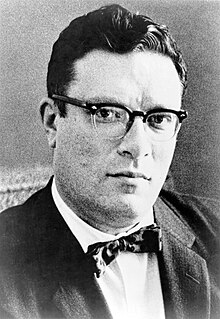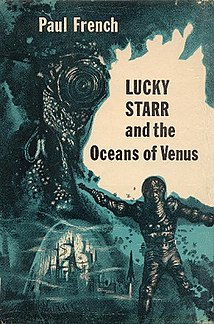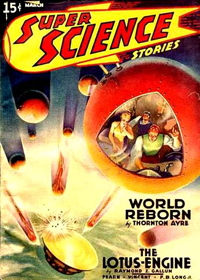
Frederik George Pohl Jr. was an American science-fiction writer, editor, and fan, with a career spanning nearly 75 years—from his first published work, the 1937 poem "Elegy to a Dead Satellite: Luna", to the 2011 novel All the Lives He Led.

Isaac Asimov was an American writer and professor of biochemistry at Boston University. He was known for his works of science fiction and popular science. Asimov was a prolific writer, and wrote or edited more than 500 books. He also wrote an estimated 90,000 letters and postcards.

The Caves of Steel is a science fiction novel by American writer Isaac Asimov. It is a detective story and illustrates an idea Asimov advocated, that science fiction can be applied to any literary genre, rather than just being a limited genre in itself.

The Robot series is a series of 37 science fiction short stories and six novels by American writer Isaac Asimov, featuring positronic robots.
A positronic brain is a fictional technological device, originally conceived by science fiction writer Isaac Asimov. It functions as a central processing unit (CPU) for robots, and, in some unspecified way, provides them with a form of consciousness recognizable to humans. When Asimov wrote his first robot stories in 1939 and 1940, the positron was a newly discovered particle, and so the buzz word "positronic" added a scientific connotation to the concept. Asimov's 1942 short story "Runaround" elaborates his fictional Three Laws of Robotics, which are ingrained in the positronic brains of nearly all of his robots. Positronic brains, as such, are a kind of brain made of positrons – small particles which help in the transmission of various thoughts and impulses to the brain and help the brain's cognition relay the selected emotion or solution.
"Robbie" is a science fiction short story by American writer Isaac Asimov. It was his first robot story and writing commenced on June 10, 1939. It was first published in the September 1940 issue Super Science Stories magazine as "Strange Playfellow", a title that was chosen by editor Frederik Pohl and described as "distasteful" by Asimov. A revised version of Robbie was reprinted under Asimov's original title in the collections I, Robot (1950), The Complete Robot (1982), and Robot Visions (1990). "Robbie" was the fourteenth story written by Asimov, and the ninth to be published. The story is also part of Asimov's Robot series, and was the first of Asimov's positronic robot stories to see publication.

Tweenies is a British live action children's television series created by Will Brenton and Iain Lauchlan. The program is centered on four pre-school aged characters, known as the "Tweenies", playing, singing, dancing, and learning in a fictional nursery in England. They are cared for by two adult Tweenies and two dogs.

Lucky Starr and the Oceans of Venus is the third novel in the Lucky Starr series, six juvenile science fiction novels by Isaac Asimov that originally appeared under the pseudonym Paul French. The novel was first published by Doubleday & Company in 1954. Since 1972, reprints have included a foreword by Asimov explaining that advancing knowledge of conditions on Venus have rendered the novel's descriptions of that world inaccurate.

In science fiction and in the beliefs of ufology, a Venusian or Venerian is a native inhabitant of the planet Venus. Many science fiction writers have imagined what extraterrestrial life on Venus might be like.

"Black Friar of the Flame" is a science fiction short story by American writer Isaac Asimov. It was first published in the Spring 1942 issue of Planet Stories and reprinted in the collection The Early Asimov (1972). "Black Friar of the Flame" was the thirteenth story written by Asimov, and was among his least favorite, though this was due more to the multiple rewrites and rejections the story suffered than to its admittedly modest intrinsic merits.
"The Callistan Menace" is a science fiction short story by American writer Isaac Asimov. It first appeared in the April 1940 issue of Astonishing Stories and was reprinted in the 1972 collection The Early Asimov. It was the second science fiction story written by Asimov, and the oldest story of his still in existence.
"The Imaginary" is a science fiction short story by American writer Isaac Asimov. It first appeared in the November 1942 issue of Super Science Stories and was reprinted in the 1972 collection The Early Asimov. Following the sale of "Half-Breeds on Venus", which was a sequel to "Half-Breed", Asimov suggested to Astounding Science Fiction editor John W. Campbell that he write a sequel to the story "Homo Sol". Campbell was unenthusiastic, but agreed. Since "The Imaginary" lacked the human-alien conflict that he had liked in the earlier story, Campbell ultimately rejected it. "The Imaginary" was the twenty-first story written by Asimov, and the twenty-ninth to be published. Due to the peculiar workings of the science fiction magazine publishing industry, "The Imaginary" appeared a month after the third story in the Homo Sol Trilogy, "The Hazing".

"The Weapon Too Dreadful To Use" is a science fiction short story by American writer Isaac Asimov. It was first published in the May 1939 issue of Amazing Stories and reprinted in the August 1965 issue of Amazing and the 1972 collection The Early Asimov. "The Weapon Too Dreadful to Use" was the eleventh story written by Asimov, and the second to be published.
"Half-Breed" is a science fiction short story by American writer Isaac Asimov. It was first published in the February 1940 issue of Astonishing Stories and reprinted in the 1972 collection The Early Asimov. It was the fifteenth story written by Asimov, and the fourth to be published. At 9000 words, it was his longest published story to date.
"Super-Neutron" is a science fiction short story by American writer Isaac Asimov, originally published in the September 1941 issue of Astonishing Stories, and included in the 1972 collection The Early Asimov. Asimov originally intended the story to be the first in a series, but was unable to come up with any further story ideas.

"The Little Man on the Subway" is a fantasy short story by Isaac Asimov and Frederik Pohl, originally published in the 1950 issue of Fantasy Book, and included in the 1972 collection The Early Asimov. It was initially written in 1941 by Asimov's friend, the author/agent/writer Frederik Pohl, under the nom de plume of James MacCreigh. Unable to get it right, Pohl asked Asimov to rewrite it, which he did. It was rejected by John W. Campbell and Asimov forgot about it. The story was finally sold to Fantasy Book in 1950.

"The Secret Sense" is a science fiction short story by American writer Isaac Asimov. It was written in 1939 and submitted to the magazine Astounding SF, but was rejected by its editor John W. Campbell, Jr.. It could not be placed by Asimov's agent, Frederik Pohl, and eventually it was taken for no payment by a new and short-lived magazine, Cosmic Stories in March 1941, although Asimov did ask for a token payment of $5 from the editor, Donald A. Wollheim, or else for the story to be published under a pseudonym, before the story was published. This was requested on the grounds that "even though the story might be worth nothing, my name was worth something". Wollheim reluctantly agreed to a payment of $5, commenting that it was an effective word rate of $2.50 per word, since he was paying only for the use of Asimov's name. Asimov described the letter from Wollheim with the $5 payment as "needlessly nasty". He later commented to Damon Knight that he might have just given Wollheim the $5 back in cash after receiving the check, but that the option never occurred to him at the time. The story was reprinted in the collection The Early Asimov in 1972.

Super Science Stories was an American pulp science fiction magazine published by Popular Publications from 1940 to 1943, and again from 1949 to 1951. Popular launched it under their Fictioneers imprint, which they used for magazines, paying writers less than one cent per word. Frederik Pohl was hired in late 1939, at 19 years old, to edit the magazine; he also edited Astonishing Stories, a companion science fiction publication. Pohl left in mid-1941 and Super Science Stories was given to Alden H. Norton to edit; a few months later Norton rehired Pohl as an assistant. Popular gave Pohl a very low budget, so most manuscripts submitted to Super Science Stories had already been rejected by the higher-paying magazines. This made it difficult to acquire good fiction, but Pohl was able to acquire stories for the early issues from the Futurians, a group of young science fiction fans and aspiring writers.
Astonishing Stories was an American pulp science fiction magazine, published by Popular Publications between 1940 and 1943. It was founded under Popular's "Fictioneers" imprint, which paid lower rates than Popular's other magazines. The magazine's first editor was Frederik Pohl, who also edited a companion publication, Super Science Stories. After nine issues Pohl was replaced by Alden H. Norton, who subsequently rehired Pohl as an assistant. The budget for Astonishing was very low, which made it difficult to acquire good fiction, but through his membership in the Futurians, a group of young science fiction fans and aspiring writers, Pohl was able to find material to fill the early issues. The magazine was successful, and Pohl was able to increase his pay rates slightly within a year. He managed to obtain stories by writers who subsequently became very well known, such as Isaac Asimov and Robert Heinlein. After Pohl entered the army in early 1943, wartime paper shortages led Popular to cease publication of Astonishing. The final issue was dated April of that year.











